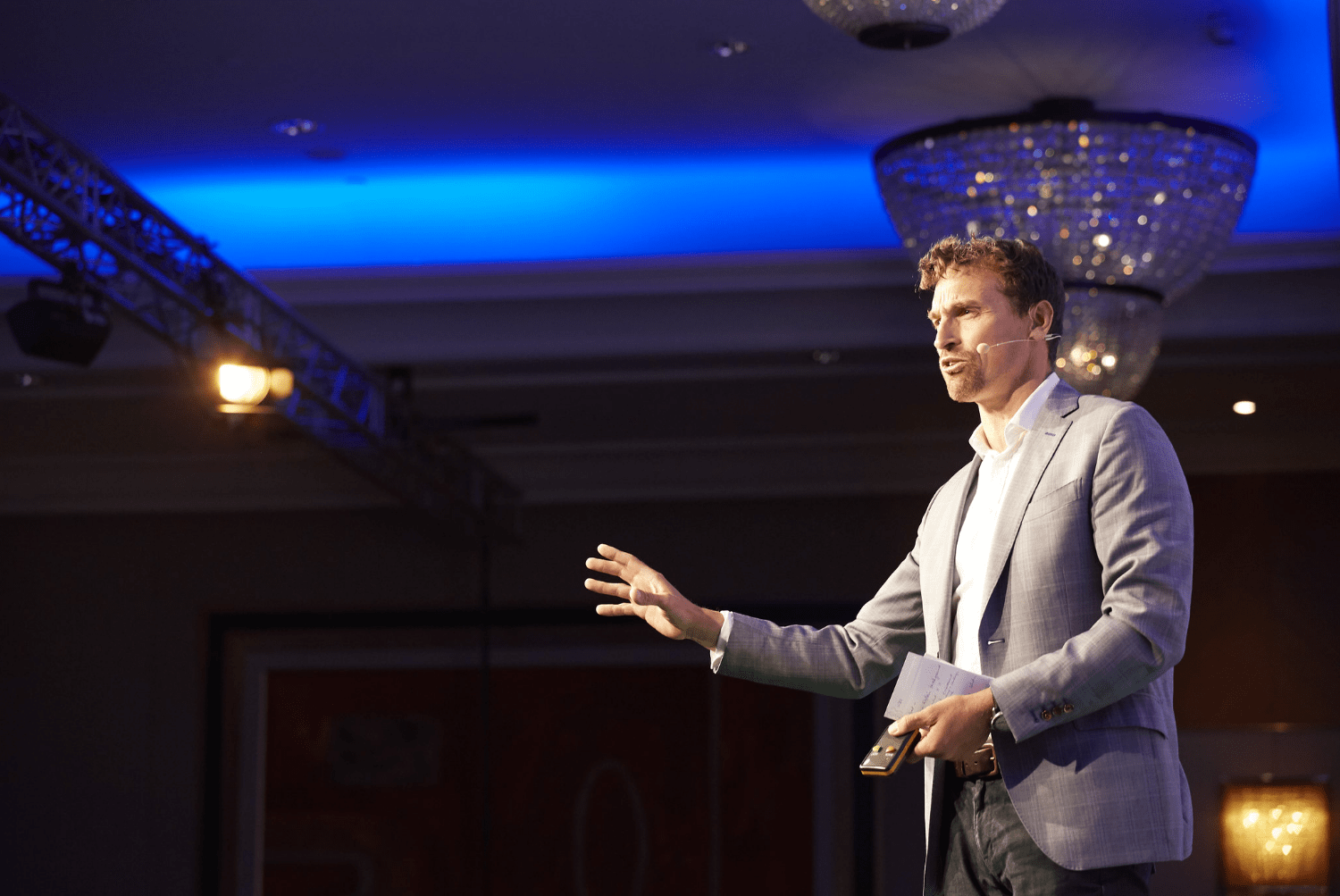 Back to News Room
Back to News Room
News

Measuring conference ROI: are conferences really worth it?
Conferences and events are commanding a bigger slice of marketing and communications budgets for businesses across the board.
According to a Bizzabo survey conducted in 2017, the majority of marketers (80%) believe live events are critical to their company’s success, and 63% plan on investing more in live events in the future - both in budget and number of events.
Whoever your target audience is, be it employees, partners, business customers or consumer audiences, face-to-face events are one of the best ways to cut-through and engage with them at a deeper and more meaningful level. Indeed, 75% of B2B marketers believe that in-person events are the most effective marketing tactic (Eventtia, 2017), and over 50% of marketers believe that one-on-one interaction at events helps to build relationships and furthers an organisation’s business goals (CMO Council & E2MA, 2013).
As the amount of money invested in event communications services continues to grow – it accounts for up to 30% of overall marketing spend for some businesses – so does the pressure to prove the return on that increased investment. However, providing solid evidence of significant conference ROI from either hosting or attending a conference is a shady area, causing key decision makers to question their value.
Almost a third of marketers (29%) claim that increasing revenue from their event strategy is their biggest challenge (Bizzabo), while research has revealed that many businesses are not placing enough importance on ROI (C&IT/Cvent), and some are not measuring conference ROI at all.
In today’s data-driven world, marketers are obsessed with analysing and proving the value of spend on other channels such as digital media. So why isn’t this same level of analysis being demanded for spend on conferences and events? Similarly, compare it to other major business investments, investing in new technology for example, and you would be required to measure the return on that spend.
Conferences can be incredibly effective, but they’re not cheap, and if you’re spending thousands of pounds on bringing together your staff or customers, they need to provide real tangible business value. And if you can prove conference ROI, then they’re definitely worth it.
Conference ROI: what could/should you be measuring?
The most important thing before deciding which metrics to actually measure, is what the objectives of the event are. Ask yourself the question, why are we running this conference? If you don’t immediately know the answer to that, then you won’t be able to effectively measure the conference's ROI.
Event objectives can range from core business objectives such as generating leads and sales, launching a new product or attracting new employees or partners, through to “softer” objectives such as building brand awareness, educating your target audience, social media exposure or driving particular behaviours.
The top five metrics marketers feel are best for quantifying event value are: new referrals and introductions; quality and quantity of leads; deal closure; value of sales; and upsell and cross-sell opportunities. Yet, only 34% use those 5 metrics to assess trade show and event ROI (CMO Council & E2MA, 2013).
It’s no surprise that the top five are more quantitative financial-related objectives as opposed to the “softer” objectives, as these tend to be easier to measure and impact the bottom line. Event management software is incredibly sophisticated these days, and there are now platforms that enable you to directly track the number of leads and sales back to a particular conference or event, and therefore prove the value it provides to the business.
But it’s important to remember that ROI can mean different things to different people within the business. For example, for an event planner, the objective might be to decrease costs or increase attendance, while the sales and marketing team might be more concerned about lead generation or social media exposure and brand uplift. So, it’s worth identifying a primary objective, for example to generate leads, and have several secondary objectives, such as to educate customers about new products or raise brand awareness. Each objective should have specific metrics attached, for example, a target for the number of leads you want to generate, so you can measure against those metrics.
If an event is more focused on awareness or changing mindsets and behaviours, you could set a target for the number of mentions on social media or press coverage you want to achieve and track the change in your net promoter score (NPS) post-event.
One of the simplest methods of collecting qualitative, usable client feedback, the Net Promoter Score is one question that surveys client feedback on an 11-point scale, measuring the likelihood of them recommending the company to a friend or colleague:
‘On a scale of 0 to 10, how likely are you to recommend this company’s product or service to a friend or colleague?’
Based on the rating received, clients can then be separated into one of three categories: detractors, passives, or promoters. This result provides an indication of the success of the event and encourages further advisory feedback from the client with ways to improve the event in the future.
Update: stay connected to suppliers
When focusing on your own conference ROI, it’s easy to overlook the ROI of suppliers that have showcased their products during your event.
By assessing the results and ROI that suppliers have taken away from your event, this can also be indication of your own event’s success. The results can also give you an indication of the ways in which you can change future events to improve your conference ROI.
Again, RFID wearables and badging can help you and your suppliers to understand how their business has (or hasn’t) benefitted from the event, and trace new customers back to the event should that have been their first point of contact with the supplier.
Smart wearables like this can create a bespoke QR code for the delegate, which holds important information which can be interchanged depending on what you want to know about your audience recorded when they register for the event. By scanning delegate badges at every supplier stand they visit and every session or workshop they attend, suppliers can see which of their leads have come from the event and allow them to calculate an ROI which has the potentially to grow continuously.
The opportunity for data collection and segmentation is equally as exciting, with the ability to collect valuable data and use it to accurately profile your audience. This data can then be read in order draw useful conclusions from the event. As an example, you could find that:
Marketing workshops attract 63% more executive-level delegates than decision-makers, whilst decision-makers spent an average of 3.5 hours speaking to between 10 and 15 suppliers.
This may only be an example, but this level of accuracy is achievable when the right technology is implemented.
The mapping of individual delegate experiences can also help you to improve their post-event customer journey. Smart rules and dynamic content can be used in follow-up communications to ensure that delegates only receive what is directly relevant to them.
Don't forget the audience!
When planning a conference or event, it’s an absolute must to focus on the audience and the ROI they get as a result of attending. Attending events costs time and money, so there has to be some value for your audience, otherwise they will think again about attending your future events.
So how do you measure ROI from an attendee perspective? Using technology is a key strategy in making events more measurable and proving ROI. Technologies such as mobile apps can enable you to track the attendee journey and provide insights into how engaged they are – it’s also a quick and easy way of getting post-event feedback on-site, instead of more traditional feedback surveys.
Making sure content is relevant to your audience goes without saying, as they’ll naturally be more engaged and get value from it. Recently, we organised a client’s ‘unconference’ conference, which provides a way of truly engaging delegates by allowing them to have a say in issues and challenges that are discussed and combatted during speaker sessions. The submission of the topics that people want to discuss can be made in wide range of engaging ways that incorporate new technologies and interactive experiences.
Technology such as RFID (Radio Frequency Identification) wearables can gather wearer data and connect them to sessions or sponsors. This way, you can collect important information on to go in order to improve post-event communications and strengthen ongoing relationships. Being able to gather on-the-go data also paves the way for geo-fencing, a mobile based technology that simply allows you to target individuals or groups within certain locations. The mobility of these technologies can work together tremendously in order to influence and directly contribute to the individual delegate’s experience, encouraging them to take a pre-orchestrated journey through the conference.
Creating particular routes and directions for delegates to follow will help you to enhance their experience and influence what they are exposed to and when they are exposed to it. Whether this is through the physical design of an area, or through virtual orientation, the ability to track delegate journeys can help to qualitatively determine if your goals and objectives have been achieved.
Along with providing insight into the individual delegate experience, these tracking methods can be beneficial during post-event analysis. When paired with heat mapping, the delegate data can indicate where and when the most popular points of an event took place – using colours to indicate the ‘heat’ of an area. This way, you can know for certain what has worked and reintroduce into future events.
Measuring the conference ROI of employee attendance
Measuring ROI from conference attendance can be equally, if not more difficult, than measuring the ROI of organising your own. You need to work out the value and benefits gained from having team members away from the office. Some of the benefits include:
- Improving your company’s presence in the industry
- Increasing awareness of your brand
- Networking and building relationships with peers
- Enabling a beneficial learning experience
These factors aren’t direct lead generators, however they are present in the lead generation process – which is, after all, a large focus of many business strategies. For example, building relationships with others in the industry is beneficial for both future collaboration and brand awareness; networking can ignite the interest of potential clients (or even generate a tangible lead), and attending informative conference sessions can provide you with tips and ideas to take back to the office and implement through your own company strategy.
Another benefit of sending employees to conferences is the impact it has on their professional development, which could in turn enhance their productivity and performance. As the number of millennials in the workplace increases, the emphasis on professional development is becoming more important because millennials are focused on learning. According to a report by PwC: “This generation is committed to their personal learning and development and this remains their first choice benefit from employers” (Millennials at Work, PWC).
Giving staff members both the responsibility of representing the company and the opportunity to develop by attending conferences could be part of a wider employee engagement strategy, but it’s important to make sure the right people go to the right events.
Conference ROI checklist:
In order to ensure that you’re getting guaranteed ROI from conferences attended by employees, there are some questions you should ask yourself to ensure that you’re getting the most from an event:
1. Who is attending the event?
The person attending an event on behalf of a company is often overlooked, yet is an extremely important factor when thinking about ROI from an event. Sending the wrong person to an event may not only be interpreted negatively by colleagues, but also by fellow event attendees and organisers. Some events specifically target senior, decision-making members of staff, so it’s essential you are aware of the attendee requirements before committing to an event.
2. What are you hoping to gain from the event?
The event has obviously caught your eye – so much so that you’re considering attending, but what is it that you are hoping to tangibly gain from the event? Whether it’s knowledge, contacts, or just promoting your company name, having an actual reason (rather than attending ‘because you should’) to attend an event that falls in line with your objectives is enough to initially justify attendance and the costs that come with it.
3. How will the event contribute to your company strategy?
When in doubt, referring back to your company strategy – which should highlight your goals and objectives, is a good way to gauge whether it’s important and justified enough for you (or a colleague) to attend. This way, you can determine exactly what the event will bring and contribute to your business, and decide whether it’s worth taking the time and resource away from your company for its duration.
In conclusion, whilst both organising and attending conferences can be costly, there are a multitude of factors that can provide a positive impact and contribute to the success of specific business goals and objectives. Whether you are focused on generating leads and building industry relationships, increasing brand awareness, or attending insightful speaker sessions – conferences offer a personable platform where key industry players can connect and communicate with one another in a laid-back, yet professional setting.
For more information about how we can help deliver conferences with guaranteed ROI, see our conference management services.




